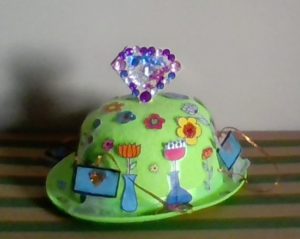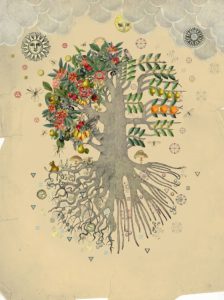Today and tomorrow, there is a 2-day summer school on science communication held at the University of Antwerp: Let’s Talk Science! During this summer school there are a large number of workshops to participate in, and lectures to attend, dealing with all aspects of science communication.

Wetenschapsbattle Trophy: Hat made by the children for the contestants of the wetenschapsbattle. Mine has diamonds and computers. 🙂
I was invited to represent Hasselt University (and science communication done by its members) during the plenary panel session starting the summer school. The goal of this plenary session was to share our experiences and thoughts on science communication. The contributions varied from hands-on examples to more abstract presentations of what to keep in mind, including useful tips. The central aim of my presentation was directed at identifying the boundary between science communication and scientific communication. Or more precisely, showing that this border may be more artificial than we are aware of. By showing that everyone’s unique in his/her expertise and discipline, I provided the link between conference presentations and presentations for the general public. I traveled through my history of science communication, starting in the middle: with the Science Battle. An event, I wrote about before, where you are asked to explain your work in 15 minutes to an audience of 6-to 12-year-olds. Then I worked my way back via my blog and contributions to “Ik heb been vraag” (such as: if you drop a penny from the Eiffel tower, will this kill someone on the ground?) to the early beginning of my research: simulating STM images. In the latter case, although I was talking to experts in their field (experimental growth and characterization), their total lack of experience in modelling and quantum mechanical simulations transformed my colleagues into “general public”. This is an important aspect to realize, not only for science communication, but also for scientific communication. As a consequence this also means that most of the tips and tricks applicable to science communication are also applicable to scientific communication.
 For example: tell a coherent story. As noted by one of my favorite authors – Terry Pratchett – the human species might have better been called “Pan Narrans”, the storytelling ape. We tell stories and we remember by stories. This is also a means to make your scien(ce/tific) communication more powerful. I told the story of my passion during science explained and my lecture for de Universiteit van Vlaanderen.
For example: tell a coherent story. As noted by one of my favorite authors – Terry Pratchett – the human species might have better been called “Pan Narrans”, the storytelling ape. We tell stories and we remember by stories. This is also a means to make your scien(ce/tific) communication more powerful. I told the story of my passion during science explained and my lecture for de Universiteit van Vlaanderen.
A final point I touched is the question of “Why?”. Why should you do science communication? Some may note that is our duty as scientists, since we are payed with taxpayer money. But personally I believe this is not a good incentive. Science communication should originate from your own passion. It should be because you want to, instead of because you have to. If you want to, it is much easier to show you passion, show your interest, and also take the time to do it.
This brought me back to my central theme: Science communication can be simple and small. E.g. projecting simulated STM images on the wall’s of the medieval castle in Ghent (Gravensteen) during a previous edition of the Ghent Light Festival.

Simulated STM of nanowires projected on the Gravensteen (Ghent) during the 2012 Light Festival). Courtesy of Glenn Pollefeyt

